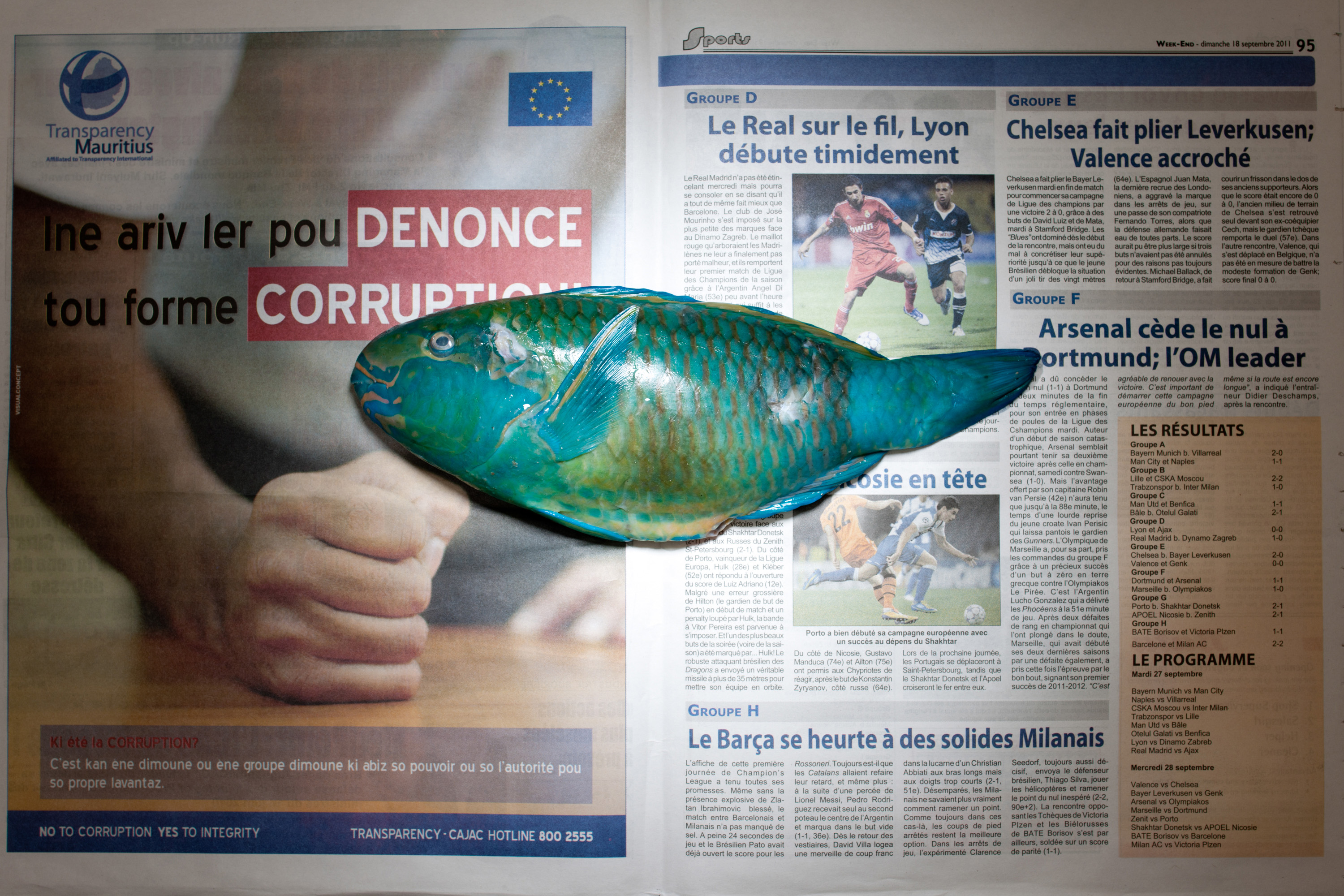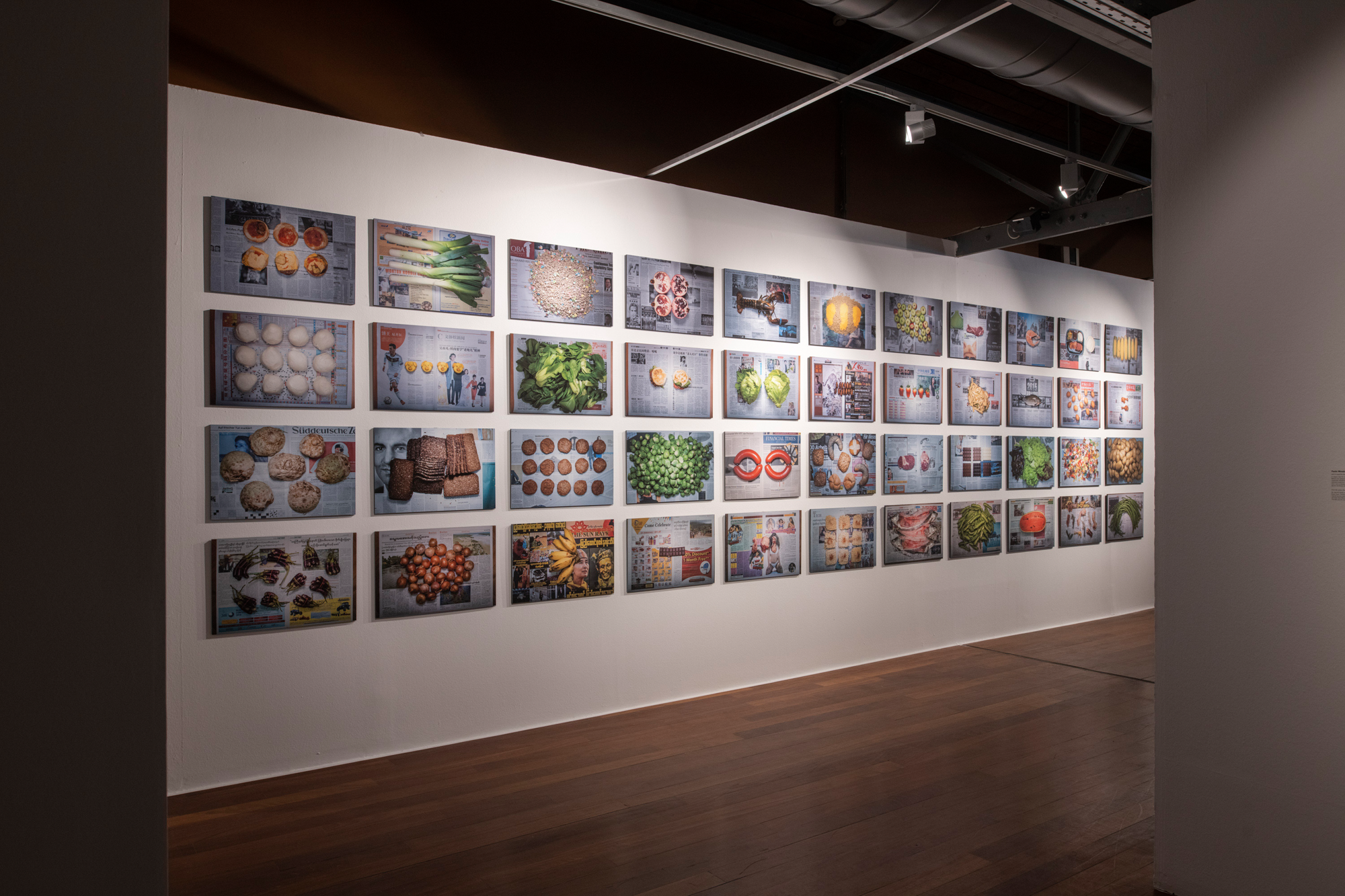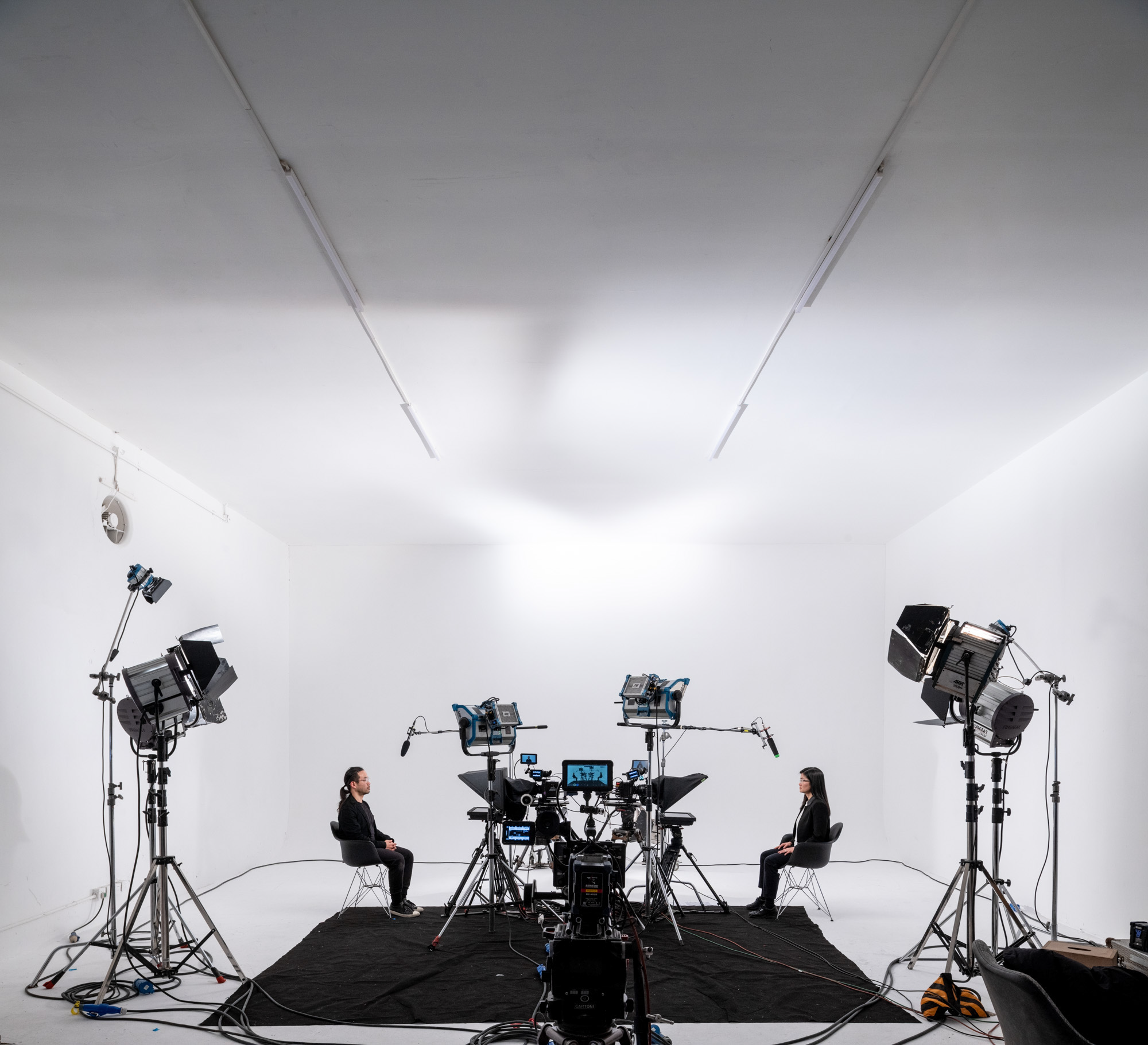Ideas
Daily Diet Economics: Interview with Chow and Lin


In December, while people around the world were stocking up on Christmas gifts in anticipation of the holiday festivities, a mysterious parcel arrived in the mail. Inside was a massive artist’s book filled with photographs of sources of protein, vegetables, fruits, and both whole-grained and heavily processed carbs, representing the daily nutritional elements needed for survival. Each of the familiar and exotic foods—from avocados to parrot fish—purchased in 36 different countries around the world, was photographed on a page of a local newspaper bearing the date the item was purchased. Curiously captivated by the visual material that fills The Poverty Line (Actes Sud and Lars Müller Publishers, 2021), including plentiful facts and figures on each country’s official poverty line, captures the growing inequality faced by people around the world over the past decade. The book was created by Chow and Lin, a Singapore- and Beijing-based husband-and-wife team who combine art and scholarly research to address urgent global issues in visual terms. Stefen Chow is an award-winning photojournalist, while Huiyi Lin, currently pursuing an MFA in experimental art at the Central Academy of Fine Arts in Beijing, is an economist by training. I recently spoke to the authors about the story behind their book.

The Poverty Line (2010–20) was a ten-year project. What led you to embark on this examination of human poverty? Was it carefully planned, or did it take a life of its own?
Chow: It happened by chance. I traveled to New York and Kolkata in the space of a week. I noticed that in New York, despite the city’s reputation for glitz and glamour, there were beggars on Wall Street. There were understated yet noticeable luxuries—iPhones were in vogue, and white earphone wires trailed from the ears of people dressed in sleek ensembles—but the poor were overlooked. In Kolkata, poverty seemed less hidden. I saw people sleeping on the road at night. It made me wonder about the experiences of poverty in different places. I relayed this over a phone conversation with Lin, who has always been concerned with societal issues. She was a civil servant in Singapore, trained in economics and public policy. She is invested in how policies affect people on the ground. That was how the project started.
You traveled to 36 countries and territories to understand the poverty lines as well as the foods that are both indigenous and popular in each place. How did you decide what to include and what to exclude in your project?
Lin: When we decided to visualize the poverty lines of these countries, food was an immediate choice as a subject. One of the basic approaches in defining poverty is absolute poverty, and that starts from measuring the amount of money needed to purchase food that fulfills the basic calorific requirements and nutrients for a person to survive. In our choice of foods, we wanted to assemble items available locally, covering carbohydrates, proteins, fruits and vegetables, and even snacks.
Many people have asked why we include snacks because those may not seem to be a necessity for someone living at a very basic poverty level. We were actually inspired by the research of two MIT economists, Abhijit Banerjee and Esther Duflo, who received the Nobel Prize for economics in 2019. One of their research findings was that if a poor person gets slightly more income on a certain day, they might choose to buy better proteins, like fish or meat, or get a toy or some snacks for the children, rather than fulfill basic caloric and nutrient needs. It’s very human—we are all fueled by wants and needs, and sometimes the former overtakes the latter. Decisions are often made on an irrational, emotional impulse rather than by reasoning. So we wanted to show that sense of choice, on a very restricted budget, and what that actually means on a daily, per person basis.
![<i>The Poverty Line</i> - Norway Oslo I October 2014 NOK 65 [USD 10.26, EUR 7.95]. Courtesy the artists.](https://artasiapacific.com/rails/active_storage/blobs/proxy/eyJfcmFpbHMiOnsibWVzc2FnZSI6IkJBaHBBbllSIiwiZXhwIjpudWxsLCJwdXIiOiJibG9iX2lkIn19--1428b24a3a9d2a532cab6d5b4ac749980430b36d/3%20TPL_Norway_2143.png)
The specific foods that you depict range from natural produce like apples and corn to heavily processed foods like instant noodles and Oreo cookies. Why these products? Are they globally popular among those living on the poverty line?
Chow: For each case study, we tried to gather foods available to the local populace through markets and grocers, depending on where food is affordable and accessible to most. We came across common foods as we shot in multiple countries over the years, and our exhibition audiences often do mental comparisons of the places, noting recurring items such as fruits, eggs, or even instant noodles. It wasn’t a deliberate decision to look at common foods, but these overlaps indicate how connected we are and how much we share. Even though instant noodles were invented by Momofuku Ando, owner of Nissin Food Products, Ltd. in 1958, the food has become so globally ubiquitous that many regard instant noodles as a staple. I was in Lagos for the project, and locals were telling me that instant noodles are a local food for them. They were surprised it was invented in Asia. The common foods also reflect the globalized nature of our food systems, logistics, as well as our parallel and diverse food cultures.
Food is an obvious way to visualize the basic needs of survival. But you are also photographing these foods against newspapers. Why did you incorporate newspapers and how do you decide which food to pair with which background?
Chow: When we started this project, we were motivated to look at poverty in a different way. We know many have opinions on this issue. Poverty can be understood as a separation within society between people who have and people who do not have. But what do all people have access to within a society? We thought for a while, and realized food and newspapers. Newspapers are often seen as an affordable public good. They are readily available, updated daily, and affordable to the masses. We are combining two elements of daily life, and using that to question a topic we seem to know.
Every photo is like a time and geographical capsule. We research the monetary figure at the poverty threshold for the country. Then we use that amount to purchase food items, which are placed on local newspapers bought on the day of the shoot. The resultant work gives us insight into what and how much people on the poverty line eat, and the time and place.
We buy as many newspapers as we can for each country. We bought about 50 newspapers in India, as there are so many of them. From the start, we made the decision to randomly combine the newspapers and the foods. The reason was simple. While we know some languages, we don’t understand many. We wouldn’t have been able to conscientiously combine the two elements across the whole body of work.

Some readers might be surprised to know how quickly countries such as China and India have eradicated or elevated many of its citizens out of poverty, while some might not know that the disparity between the rich and the poor is most pronounced in the United States. Why do you think this kind of information is not more widely known?
Lin: Our mental images of poverty often comprise homeless people, people living in impoverished rural villages, or children who do not go to school. That is certainly a part of what needs attention. But what we learned as we did this project is that poverty is not just about extreme or absolute poverty. Poverty exists in all societies, and is recognized and defined differently, depending on local circumstances and economic resources, as well as social expectations. A lot of developed economies actually focus more on relative poverty, and the working poor are less apparent. For example, in Europe, the poverty line is set at 50 or 60 percent of the median income of the population. The concern is not basic survivability but inequality and access to opportunities and services. It’s harder to have a sense of who is really being left out of society, based on having less opportunity and less social and political engagement. In some cultures, people don’t necessarily come out to ask for help or they may not even realize they are considered poor in their society.
From your research, is the majority of the poor made up of men or women, or is poverty gender neutral?
Poverty rates are commonly higher among women than men in many countries. As women tend to have lower earnings, this pay gap compounds over years and they end up with less savings and fewer assets. Women also need to manage work and caregiving, and often their childbearing responsibility means absence from the work force. Especially in developing countries, many women work in the informal economy where they do not have social protection and proper labor contracts, and access to education is more limited for young girls.
What were the original aims of this project? And do you think you achieved these aims?
Chow: We had no expectations when we started The Poverty Line back in 2010. It was really meant as a personal endeavor for the two of us to educate ourselves on this question: What does poverty mean?
Over the last 10 years, we have committed more time and effort to this one single project than anything else that we've done before, and most of it is self-funded. I think the biggest reward for us is not just learning how poverty exists in different ways across the globe, but also interfacing with different academics and experts who have far more knowledge in similar topics and beyond.
This has also set us on a trajectory in the last 12 years, working on global tipping-point issues as an artist duo. The Poverty Line has a cross-disciplinary versatility because it is considered visual art in artistic circles, and is also accepted and referenced in the academic and sociopolitical world. We do feel this project is bigger than the sum of the two of us. It has definitely surpassed our expectations.

You have exhibited this project in numerous countries. What has been the response in these various locations?
Chow: I remember the packed opening at the Thessaloniki Museum of Photography in 2018. The audience instinctively understood the meaning behind the work. Greece is culturally very rich. They have also undergone financial turmoil, and they saw the work with concern and empathy.
When we exhibited in 2016 at the CAFA Museum in Beijing, a father brought his child to see the show. They ended up spending half the day after the child became completely fascinated. The father contacted us later to relay how touched they were. He was also surprised how interested and receptive his child was to the concept of the work.
Beyond the exhibition and the book, do you share your data with NGOs that address poverty?
Lin: We use a lot of statistics and policy information from government agencies, developmental organizations, and NGOs, and we openly reference the sources. We have worked with researchers, NGOs, and institutes to exchange findings and raise public awareness. We were invited by the United Nations Economic and Social Commission for Asia and the Pacific in 2018 to exhibit and share the project at their conference on social development. The attendees, consisting of ministers, policy officials, and UN staff were interested to discuss how visual art can engage public audiences. We are trying to build more interdisciplinary sharing with NGOs, governments, and researchers who are doing important work in these areas.

Now that you have completed this project, how do you think poverty can be overcome? Or do you think it is inevitable?
Lin: Poverty exists in different forms. The Covid-19 crisis has erased a lot of the progress that we've had with reducing extreme and absolute poverty, as all countries have been hit—especially developing economies with less economic resilience. And within societies, the pandemic has impacted the poor more because they lack job stability, do not have the ability to work from home, and lack access to healthcare and education. In the long run, for middle- and high-income economies, inequality is a significant issue. What are the opportunities and access that people should have? I think that’s the bigger question that comes with development.
Chow: In the end pages of our book, we published the poem The Flower Market by Bai Juyi, a famous Chinese poet and government official who lived during the Tang Dynasty. In the poem, he describes a scene involving the purchase of peony flowers during spring. The first 16 sentences detail seemingly passive observations of a crowded marketplace. However, the last four sentences are a veiled critique of society’s consumption and distribution structure: “A cluster of deep-red flowers would pay the taxes of ten poor houses.”
Poverty isn’t new. Segregation between classes has been around since societies were formed. But we can certainly seek to address structural factors of inequality, provide social protection and access to opportunities, and minimize the gap.

What are you working on now?
Lin: We just started a 40-year work in December 2021. The working title is The Conversation. Basically, we sit across each other and speak for 12 hours, about our personal values, inequality, consumption, justice, the climate crisis, and how we see ourselves as artists, parents, and humans. And we plan to download these capsules of our thoughts every ten years, until one of us passes away. Hopefully we can do it until we’re 80 years old. We realize our own impermanence, and the wider context of knowledge accumulation and interpretation, so we use AI tools to connect our thoughts and words with broader bodies of human memory and consciousness.
We have also just launched our first NFT work, Decentralized Value Systems (2021), which questions the perception of value in the modern economic construct where prices are an omnipresent determinant of demand and desirability. In a world increasingly edging into virtuality, the purpose of money is redefined and desensitized. It centers around the mantou, a plain, steamed bun that is a staple in northern China.







